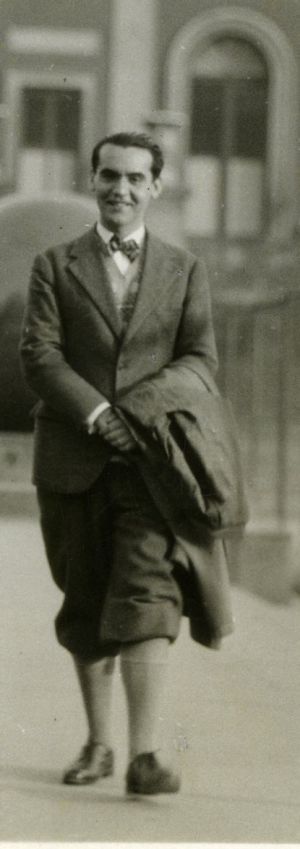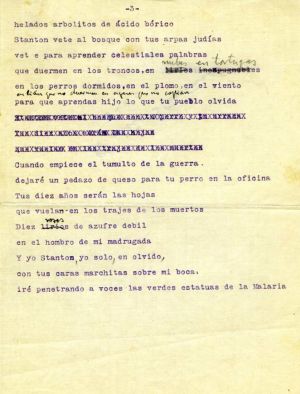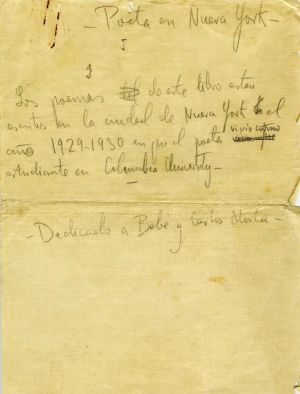 |
| Federico García Lorca New York, 1929 |
A Lorca spring in the Big Apple
The city is celebrating his stay and his influence with around 20 activities and two exhibitions
Andrea Aguilar
Madrid, 27 March 2013

In his verses he wrote about "the false dawn of New York,” about "the cindered windows of Broadway" and about "sand, caiman and fear," gutting the avenues of the Big Apple in powerful images that signaled a before and an after in his poetry. Federico García Lorca arrived here in June 1929 and left in March of the following year to go to Cuba. He did not learn English as he had hoped to when he enrolled at Columbia, but when he left he took with him a number of poems that would end up forming the basis for his Poeta en Nueva York.
Although there is no round anniversary to justify it, for the next three months the city will pay tribute to the man whom it inspired to make his anguished, surrealist cry. Ironically, New York is also the city that his relatives chose for exile, and where the poet’s father died. But what New York is celebrating in the spring of 2013 is the collection of poems that arose from those intense nine months in 1929-1930.
The busy activity program includes a Patti Smith concert (scheduled for June 5, the day of Lorca’s birth), a lecture by the poet and literary critic Gonzalo Sobejano at Columbia University, a puppet show at SEA Theater in the Lower East Side; and a walking tour of the places where Lorca stopped.
“In the cultural world, Lorca’s influence never ends. The Lorca who lived in New York was the most modern Lorca,” says Javier Rioyo, director of the Cervantes Institute in the city, which will screen movies based on Lorca’s work, host talks and give presentations. But the Cervantes – the Spanish equivalent of the British Council – is just one of a dozen or so centers participating in the festival, including the King Juan Carlos Center at New York University, City University of New York and BOMB magazine. The poet will even get his own radio show, Radio Lorca, courtesy of ArtonAir. The festival was organized by the Federico García Lorca Foundation, Acción Cultural Española and the New York Public Library, with support from La Caixa.
Laura García Lorca, director of the Foundation and niece of the famous author, explained the genesis of the festival in a telephone interview.
“We started thinking about how best to launch the García Lorca Center in Granada and what kind of programming would be best suited to this legacy,” she said. “We have tried to underscore the meaning of Lorca’s work today, with a program for all types of audiences that encourages dialogue among artists. The response has been fantastic.”
 ampliar foto
ampliar foto
One of the highlights of the “Lorca spring” is an exhibition at the New York Public Library (NYPL) called Back Tomorrow: A Poet in New York, which for the first time puts on public display a nearly complete series of drawings that Lorca made in the city, as well as his last manuscript of Poet in New York – the very same one that he left on the Madrid desk of his publisher José Bergamín with a note saying “I think I’ll be back tomorrow,” shortly before being executed in Granada and buried in an unmarked mass grave.
The original idea, Laura García Lorca explains, was to organize this show at the new Granada center and to later have it travel to New York. But successive delays in the center’s inauguration changed the order of events.
The show, which is curated by Christopher Maurer and Andrés Soria Olmedo, brings together personal objects such as Lorca’s guitar, passport, photographs and other manuscripts. It does not follow a chronological order. “We chose to focus on key issues of García Lorca’s New York experience: his life as a student at Columbia, his reaction to Wall Street [he was an eyewitness to the 1929 crash and the ensuing scenes of despair and ruin], his discovery of the rich African American culture and of racial prejudice, his prodigious ability to transform reality, and finally the story of the manuscript itself,” says Maurer.
This scholar also notes that the New York of 1929 holds echoes in the present: “We are now experiencing the consequences of the social ills that Lorca pointed out in 1929.”

Paul Holdengräber, creator of the unorthodox and by now legendary series LIVE NYPL, will organize one of his literary happenings with writers, poets and singers.
“It will not be a reaction to the exhibition, but about bringing together a series of artists who will share with us their love of Lorca, whose body of work is admired by the likes of John Ashbery, Leonard Cohen and Jim Harrison. We will be able to hear original, unreleased recordings that the Foundation gave us. The element of surprise is very important to me, and this will also be a gift for the city,” says Holdengräber, who believes that mystery plays an essential role in the fascination that Lorca and his oeuvre continue to exert.
While working on Poet in New York, Lorca traveled to Vermont with the poet Phillip H. Cummings, and this stay is the focus of another exhibition. Back in Spain, Lorca spent several years mulling over his New York material; he wrote an introductory speech to the poems and even contemplated the possibility of publishing his verses in two separate books. By early July 1936 he had already made up his mind, and he went over to the newsroom of Cruz y Raya, thinking of discussing the project with his publisher Bergamín. Not finding him in, Lorca left his famous note saying he would be “back tomorrow,” right before being summarily executed.
The poet wrote “The New York dawn grieves/ along the immense stairways/seeking amidst the groins/ spikenards of fine-drawn anguish.” Now, the dawn heralds a celebration of his verses in the greatest “Lorca Spring” in New York memory.


No comments:
Post a Comment